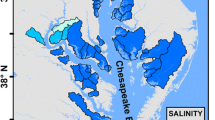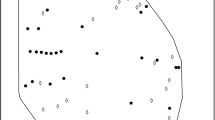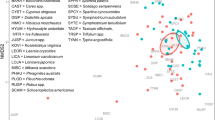Abstract
Quantifying the relative value ofPhragmites australis andSpartina alterniflora habitat is important to evaluate the benefits and risks of different attempts to addressPhragmites expansion on the U.S. eastern seaboard. Two contrasting approaches commonly used to restore tidal marsh habitats invaded byPhragmites communities involve sprayingPhragmites with herbicide only when its coverage of a particular marsh area is near or close to 100%. Alternatively, after the first application, herbicide is annually applied on any surviving patches ofPhragmites present in a mosaic of other marsh vegetation. A model is introduced to evaluate the relative habitat value of these control regimes, here termed the Intermittent and Continuous. Compared to the Intermittent approach, the area of herbicide application in the Continuous approach is higher in the first 6 yr, but lower the reafter. The cumulative gain in habitat quality after 20 yr in either approach is sensitive to the presumed relative values ofPhragmites versusSpartina habitat, and may even be negative if they are nearly equal. Annual applications of herbicide to patches ofPhragmites appears to generate more habitat value and with less herbicide than occasional applications whenPhragmites cover is at is maximum.
Similar content being viewed by others
Literature Cited
Able, K. andW. S. M. Hagan. 2000. Effects of common reed (Phragmites australis) invasion on marsh surface macrofauna: Response of fishes and decapod crustaceans.Estuaries 23:633–646.
Bertness, M. D., P. J. Ewanchuk, andB. R. Silliman. 2002. Anthropogenic modification of New England salt marsh landscapes.Proceeding of the National Academy of Sciences (USA) 99: 1395–1398.
Besitka, M. R. A. 1996. An ecological and historical study ofPhragmites australis along the Atlantic coast. Masters Thesis, Drexel University, Philadelphia, Pennsylvania.
Chambers, R. M., L. A. Meyerson, andK. Saltonstall. 1999. Expansion ofPhragmites australis into tidal wetlands of North America.Aquatic Botany 64:261–273.
Chambers, R. M., D. T. Osgood, andN. Kalapasev. 2002. Hydrologic and chemical control ofPhragmites growth in tidal marshes of SW Connecticut, USA.Marine Ecology Progress Series 239:83–91.
Evans, P. R. 1986. Use of herbicide ‘Dalapon’ for control ofSpartina encroaching on intertidal mudflats: Beneficial effects on shorebirds.Colonial Waterbirds 9:171–175.
Feist, B. E. andC. A. Simenstad. 2000. Expansion rates and recruitment frequency of exotic smooth cordgrass,Spartina alterniflora (Loisel), colonizing unvegetated littoral flats in Willapa Bay, Washington.Estuaries 23:267–274.
Fell, P., S. P. Wissbach, D. A. Jones, M. A. Fallon, J. A. Zeppieri, E. K. Faison, K. A. Lennon, K. J. Newberry, andL. K. Reddington. 1998. Does invasion of oligohaline tidal marshes by reed grass,Phragmites australis (Cac.) Trin. ex Steud., affect the availability of prey sources for the mummichog,Fundulus heteroclitus L.Journal Experimental Marine Biology and Ecology 222:59–77.
PSE&G. 2001. Cedar Swamp and the rocksPhragmites-dominated wetland restoration sites, Blackbird and Appoquinimink Hundreds, New Castle County, Delaware, 2000 site status report dated 29 June 2001, to the New Jersey Department of Environmental Protection—Land Use Regulation Program. U.S. Army Corps of Engineers and Management Plan Advisory Committee by Public Service Electric and Gas Co., Inc., Salem, New Jersey.
Saltonstall, K. 2002. Cryptic invasion by a non-native genotype of the common reed,Phragmites australis, into North America.Proceeding of the National Academy of Science (USA) 99: 2445–2449.
Stevenson, C., J. E. Rooth, M. S. Kearney, andK. L. Sunderg. 2000. The health and long term stability of natural and restored marshes in Chesapeake Bay, p. 709–735.In M. Weinstein and K. Kreeger (eds.), Concepts and Controversies in Tidal Marsh Ecology. Kluwer Academic Publishing. Dordrecht, The Netherlands.
Wainwright, S. C., M. P. Weinstein, K. W. Able, andC. A. Currin. 2000. Relative importance of benthic microalgae, phytoplankton and the detritus of smooth cordgrass (Spartina) and the common reed (Phragmites) to brackish marsh food webs.Marine Ecology Progress Series 200:77–91.
Warren, R. S., P. E. Fell, J. L. Grimsby, E. L. Buck, C. G. Rilling, andR. A. Fertik. 2001. Rates, patterns, and impacts ofPhragmites australis expansion and effects of experimentalPhragmites control on vegetation, macroinvertebrates, and fish within the tidelands of the lower Connecticut River.Estuaries 24:90–107.
Weinstein, M. P. andJ. H. Balletto. 1999. Does the common reed,Phragmites australis, affect essential fish habitat?Estuaries 22:793–202.
Weinstein, M. P. andS. Y. Litvin. 2000. The role of tidal salt marsh as an energy source for marine transient and resident finfishes: A stable isotope approach.Transactions American Fisheries Society 129:797–2000.
Weis, J. S., L. Windham, C. Santiago-Bass, andP. Weis. 2002. Growth, survival, and metal content of marsh invertebrates fed diets of detritus fromSpartina alterniflora Loisel. andPhragmites australis Cav. Trin. ex Steud. from metal-contaminated and clean sites.Wetlands Ecology and Management 10:71–84.
Author information
Authors and Affiliations
Corresponding author
Rights and permissions
About this article
Cite this article
Turner, R.E., Warren, R.S. Valuation of continuous and intermittentPhragmites control. Estuaries 26, 618–623 (2003). https://doi.org/10.1007/BF02823737
Received:
Revised:
Accepted:
Issue Date:
DOI: https://doi.org/10.1007/BF02823737




